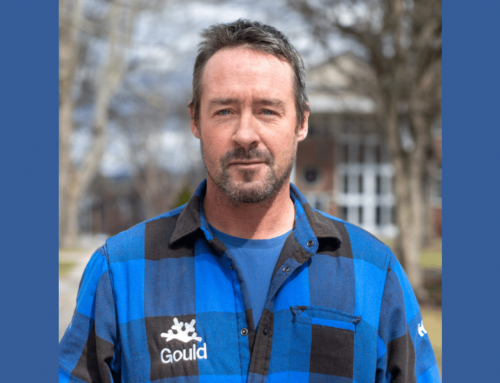Leif Nestvold-Haugen: From DU to World Cup success
As a boy growing up in Lommedalen, Norway, Leif Nestvold-Haugen started skiing on cross-country skis as soon as he could walk. It’s an activity he still enjoys — assuming he doesn’t have to be in a hurry — and it laid the foundation for one of the great NCAA-to-World Cup success stories in recent memory.
At age five, his family moved to a new home close to a small ski area, so close he was able to walk there as a child. There is joy in his voice when describing how his friends and he would spontaneously design a “ski cross” course. The Viking pack would decide the details of the run, determining which tree to ski around, which bumps to jump, and how to traverse the slope. The finish of the course was often defined by skiing directly onto the lift. It was purely playing on skis.
As Haugen sees it, before he started training, he started racing. He remembers his parents “throwing (him) into ski races.” During that process, Haugen realized that racing wasn’t something he wanted to do; it was something he needed to do, and a ski area he could walk to and friends to ski with is a perfect storm for success.
In 2006, Haugen’s career took a challenging turn. In the summer after his senior year of high school, the newly named member of the Europa Cup team was training super G on the Juvass Glacier when he crashed, sustaining a tibia and fibula open fracture and compartment syndrome. Suddenly, his focus was on recovery, and he wouldn’t return to competition for eight months.
Haugen would ski another season with the Norwegian Europa Cup group. He now realized, however, that ski racing is a fragile occupation. Circumstances had set the stage for Andreas Kilde, a lifelong friend, to convince Haugen to visit the University of Denver. It was on that trip that Haugen realized ski racing collegiately would be more fun and a more rewarding path to achieving his goals.

Haugen only does things that interest him, and he is a person who pursues whatever it is that makes him happy. It is not surprising the visiting Haugen would ultimately decide to continue his education and develop his ski racing while attending the University of Denver. It was clear if he took advantage of the opportunities DU could offer, he would achieve both his World Cup and academic goals. Haugen realized the university provided many positive benefits that were both convenient and efficient, and these things would benefit him in achieving his desired outcomes.
Haugen is and always has been his own man. He is not afraid of making decisions. Upon leaving the Norweigian national team, like most collegiate athletes, Haugen would have to organize his summer training. He did so by cooperating with Guenther Birgmann and his Treblecone Race Academy.
Prep period training as an NCAA athlete was an issue Haugen identified, and a problem he solved. He entered the University of Denver in the fall of 2008 as a freshman at the age of 21, skiing for the DU Pioneers during his freshman and sophomore years. He fully intended to help the team to another championship in his junior year; however, it was evident that, primarily because of scheduling conflicts, proper preparation for the World Championships precluded him from participating in his junior year of racing collegiately. His new athletic priorities, however, did not deter him from continuing and completing his education.

Contrary to the desire of some in the Norwegian Ski Federation, Haugen was determined to finish school in four consecutive years. While at DU, the business degree he would receive was as valued by Haugen as his development in ski racing.
“I intended to finish what I started,” he said.
With Haugen willing to chart his course, he followed a unique plan to progress onto the World Cup from Denver, deciding to only compete in North American races while skiing for DU, notably forgoing Europa Cups.
“I didn’t feel a need to ski the Europa Cup,” said Haugen. He had a “gut feeling, and it made sense” that skiing races in North America would help develop the confidence needed to compete in the World Cup. “To win any race, you must ski well. There are a lot of good skiers out there,” he says.
By his sophomore year, Haugen qualified for his first World Cup race, debuting in the giant slalom at Soelden in 2009. Thanks to a strong opening performance, Haugen was able to add more World Cup starts and the Winter Olympic Games in Vancouver to his sophomore competition schedule.
Even after he finished his collegiate career and while establishing himself on the World Cup, Haugen continued to compete on the NorAm circuit. Haugen started in 18 NorAm races over the next three seasons while skiing full time on the World Cup as a Norwegian national team member. He won two, a pair of slaloms to go along with a GS victory he recorded as a freshman Pioneer.
Physiologically, in the U.S., Haugen learned the value of keeping the tension out to the shoulders or “shoulders down,” as he says. From his school experience, he learned to keep things in perspective. Haugen reflects fondly about his time as a Pioneer, enjoying ski racing as a team. “We were in it together,” he says — a unique and positive experience to win and lose together.
“You could win the race, but you still need a team that delivered, or you could have a bad day and still win the NCAA championship,” he said.
Haugen says that at the University of Denver, he made great friends and significantly improved as a racer; it is one of his most valued experiences. It is interesting to note that Haugen’s Olympic bronze medal-winning performance in the alpine team event consisted of two collegiate skiers, both of whom had experience performing at a high level in a team setting.
Haugen completed his studies and graduated from the University of Denver in the spring of 2012 at the age of 25.
These days, it’s family first. Haugen is fortunate to have a job he loves, but if you want to have a conversation at length, ask him how his family is doing. Today, he still lives close to a small ski area, so close his kids can walk there when they get a little older.





















